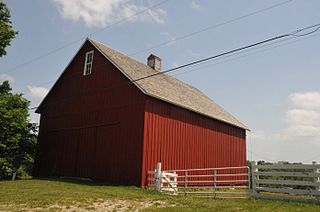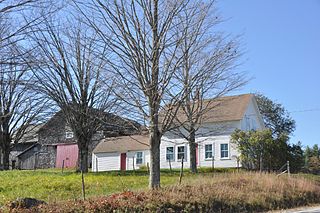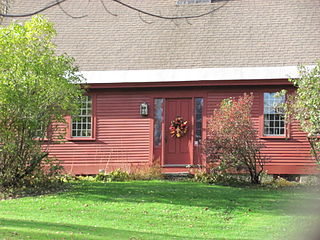
Westphalia is a small unincorporated community in Falls County, Texas, United States located 35 mi (56 km) south of Waco on State Highway 320. Westphalia has a strong German and Catholic background. The Church of the Visitation was, until recently, the largest wooden church west of the Mississippi River. Westphalia is mainly noted for its historic church and convents, but also for its meat market and for its annual church picnic, which is one of the largest in the area. Westphalia is also known for the Westphalia Waltz.

The McClelland Homestead is a historic farm in western Lawrence County, Pennsylvania, United States. Located along McClelland Road northeast of Bessemer, the farm complex includes buildings constructed in the middle of the 19th century. It has been designated a historic site because of its well-preserved architecture.

The Charles C. Fitch Farmstead is a historic farm property located in Eugene, Oregon. It was listed as a historic district on the National Register of Historic Places (NRHP) on June 16, 1989.

The Nelson Farm is a historic farmstead in rural Merrick County, in the east central part of the state of Nebraska in the Midwestern United States. Originally settled by Swedish immigrants in 1879, it was expanded and improved over the subsequent eighty years and more, remaining in the founder's family into the fourth and fifth generations.

The Robert William Andrew Feller Farmstead is a federally designated historic site a couple miles northeast of Van Meter in Dallas County, Iowa, United States. It is the boyhood home of Major League Baseball Hall of Fame pitcher Bob Feller. The historic district is 1.2 acres (0.49 ha). The Feller family farm was once 350 acres (140 ha) but most of it has been sold to other farmers and the current farm is 40 acres (16 ha). Feller sold the farmstead in 1955 and it is currently owned by Dr. Jose Angel since about 1994.

The Durham–Perry Farmstead is a park and open-air museum in Bourbonnais, Illinois on the grounds of the former Thomas Durham farm. The buildings reflect the agricultural practices of Illinois farmers in the 19th and early 20th centuries. The heavy timber framed buildings are representative of northern Illinois construction trends between the 1830s and 1850s.

The Hersey Farms Historic District of Andover, New Hampshire, includes two farmsteads belonging to members of the Hersey family, located on the Franklin Highway in eastern Andover. The older of the two farms, the Guy Hersey Farm, was established c. 1850 by Hiram Fellows, and has been in the Hersey family since 1904. The adjacent James Hersey Farm was established in 1833 by Alfred Weare, and was acquired by Guy Hersey's son James in 1945. The two farms encompass 325 acres (132 ha), and were listed on the National Register of Historic Places in 2008.

The Helvig–Olson Farm Historic District is an agricultural historic district located in rural Clinton County, Iowa, United States, 3 miles (4.8 km) southwest of the town of Grand Mound. It was listed on the National Register of Historic Places in 2000.

Park Farm is a historic farm property at 26 Woodchuck Hill Road in Grafton, Vermont. With a farmhouse dating to about 1820, and most of its outbuildings to the 19th century, the farm remains an excellent example of a typical 19th-century Vermont farmstead. The property was listed on the National Register of Historic Places in 2003.

The Charles Spangenberg Farmstead is a historic farm in Woodbury, Minnesota, United States, established in 1869. The three oldest buildings, including an 1871 farmhouse, were listed together on the National Register of Historic Places in 1978 for having local significance in the theme of agriculture. The property was nominated for being one of Washington County's few remaining 19th-century farmsteads.

The Brugjeld–Peterson Family Farmstead District, also known as Lakeside Farm and the Peterson Point Historical Farmstead, is a historic district in rural Emmet County, Iowa, United States, near the town of Wallingford. It was listed on the National Register of Historic Places in 2000.

The David Hanaford Farmstead is a historic farm in Monticello Township, Minnesota, United States. It was first settled in 1855 and features a farmhouse built in 1870 and a barn from around the same time. The farmstead was listed on the National Register of Historic Places in 1979 for having local significance in the themes of agriculture and exploration/settlement. It was nominated for being "an excellent example of an early Wright County farmstead developed by a pioneer family from New England."

The Atherton Farmstead is a historic farm property at 31 Greenbush Road in Cavendish, Vermont. The farmhouse, built in 1785, is one of the oldest in the rural community, and is its oldest known surviving tavern house. It was listed on the National Register of Historic Places in 2002.

The Chris Poldberg Farmstead is a collection of historic domestic and agricultural buildings located southeast of Jacksonville, Iowa, United States. It was listed on the National Register of Historic Places in 1991. The historic importance of the farmstead is its association with stock farming, an important industry associated with Danish immigrants who settled in Shelby and Audubon counties from 1865 to 1924. The historic designation includes the two-story, foursquare, frame house (1907); the Midwest three portal barn (1912); hog house (1914); poultry house (1914); machine shed (1914); and cob house (1914). The house was built by Carl V. Andersen, and the barn, machine shed, and hog house by Jacksonville carpenter gangs.

The Andrew P. Hansen Farmstead is a collection of historic domestic and agricultural buildings located northwest of Brayton, Iowa, United States. Hansen was born in Fyn, Denmark, and was five years old when the family immigrated to the United States, settling in Avoca, Iowa. He worked for the Chicago, Rock Island and Pacific Railroad there before buying his first 40 acres (16 ha) from the railroad. The farm eventually grew to 120 acres (49 ha). It was listed on the National Register of Historic Places in 1991. At the time of its nomination the farm included five contributing buildings including the transverse-frame dairy barn (1894), the hog house, the 1½-story American Foursquare house (1901), the Midwest three portal cattle barn (1903), and a garage (1910s). It also includes one contributing structure, the double corn crib. The house and the barns are characteristic of the building trends that are associated with Danish immigrants during the period of significance, in this case 1894–1924.

Tyden Farm No. 6 Farmstead Historic District is an agricultural historic district located east of Dougherty, Iowa, United States. It was listed on the National Register of Historic Places in 2009.

The Dan Johnson Farmstead is a historic farm property on United States Route 2 in Williston, Vermont. It was first developed in 1787 by Dan Johnson, one of Williston's first settlers, and has remained in his family since that time. The property includes three 19th-century houses and a large barn complex, as well as more than 200 acres (81 ha) of land crossed by US 2 and Interstate 89. It was listed on the National Register of Historic Places in 1993.

Lee Farm is a historic farm property on Vermont Route 18 in Waterford, Vermont. Established in 1801, it was for many years worked by members of the Lee family, and part of a thriving rural community called Waterford Hollow. Its farmstead features surviving 19th and early 20th-century outbuildings and a high-quality Greek Revival farmhouse. A 5-acre (2.0 ha) portion of the farm, encompassing the farmstead, was listed on the National Register of Historic Places in 1983.

The John and Marie (Palen) Schrup Farmstead Historic District is a nationally recognized historic district in Dubuque County, Iowa, United States. It was listed on the National Register of Historic Places in 2009. At the time of its nomination it consisted of four resources, which included three contributing buildings and one non-contributing building. The three buildings include a stone house, barn, and well-house. The buildings are typical of those constructed by immigrant families from Luxembourg that settled in Dubuque and nearby Jackson counties. The front part of the house is the oldest structure here and was built when Martin Burkhart owned the property. He sold the farmstead to Casper Burkhart the following year, who then sold it to John and Marie Schrup in 1856. The Schrups were responsible for adding onto the back of the house about the time they bought it and the other two buildings. The dairy farm of 193 acres (78 ha) remained in the family until 1973. Because it was always a modest enterprise, the stone buildings were not torn down and replaced with modern structures as happened on many of the Luxembourgian farms built in the mid-19th century. A wooden shed was built in the early 20th century, and is the non-contributing building. A pole barn was also added to the farmstead and it fell down c. 1995.

The George Louk Farm is a rural farmstead located at 1885 Tooley Road near Howell, Michigan. It was listed on the National Register of Historic Places in 1995.




















